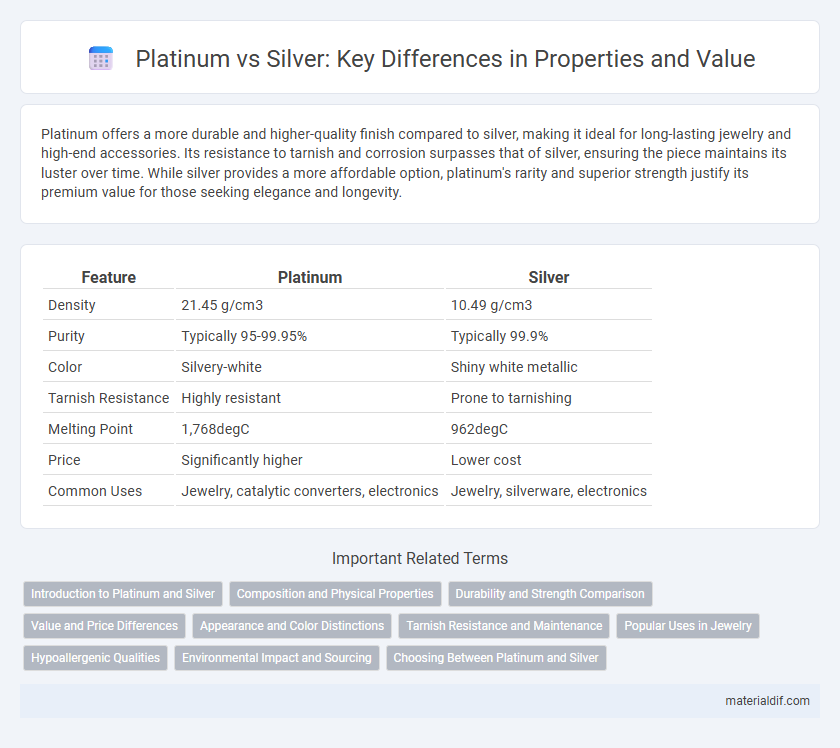Platinum offers a more durable and higher-quality finish compared to silver, making it ideal for long-lasting jewelry and high-end accessories. Its resistance to tarnish and corrosion surpasses that of silver, ensuring the piece maintains its luster over time. While silver provides a more affordable option, platinum's rarity and superior strength justify its premium value for those seeking elegance and longevity.
Table of Comparison
| Feature | Platinum | Silver |
|---|---|---|
| Density | 21.45 g/cm3 | 10.49 g/cm3 |
| Purity | Typically 95-99.95% | Typically 99.9% |
| Color | Silvery-white | Shiny white metallic |
| Tarnish Resistance | Highly resistant | Prone to tarnishing |
| Melting Point | 1,768degC | 962degC |
| Price | Significantly higher | Lower cost |
| Common Uses | Jewelry, catalytic converters, electronics | Jewelry, silverware, electronics |
Introduction to Platinum and Silver
Platinum and silver are both precious metals known for their rarity and value, but platinum is denser, more durable, and highly resistant to tarnish compared to silver. Silver has greater electrical conductivity and is widely used in industrial applications, while platinum is favored in automotive catalytic converters, jewelry, and high-end electronics. The distinct physical and chemical properties of platinum make it a premium choice for investment and luxury goods, whereas silver's affordability and versatility ensure its broad usage across various industries.
Composition and Physical Properties
Platinum is a dense, malleable metal with a high melting point of 1,768degC and a purity often exceeding 95%, primarily composed of the element Pt (atomic number 78). Silver, with the chemical symbol Ag (atomic number 47), is less dense and has a lower melting point of 961.8degC, typically found in compositions of 92.5% silver in sterling silver alloys. The superior corrosion resistance and higher density of platinum make it more durable and suitable for industrial applications compared to silver, which is more prone to tarnishing.
Durability and Strength Comparison
Platinum exhibits significantly higher durability and strength compared to silver, making it more resistant to scratches and tarnishing over time. Its density is approximately 21.45 g/cm3, almost double silver's 10.49 g/cm3, contributing to its superior hardness and longevity in jewelry and industrial applications. This exceptional resilience ensures that platinum maintains its luster and structural integrity even under frequent wear conditions.
Value and Price Differences
Platinum is significantly rarer than silver, contributing to its higher value and price on global markets. Despite silver's widespread industrial applications, platinum's scarcity and demand in automotive catalytic converters and jewelry maintain its premium price point. Market fluctuations tend to affect silver prices more dramatically, while platinum retains a more stable, elevated value due to its limited supply and specialized uses.
Appearance and Color Distinctions
Platinum exhibits a naturally white, lustrous sheen that retains its brightness and resists tarnishing, whereas silver often has a warmer, slightly yellowish hue that can darken over time due to oxidation. The dense molecular structure of platinum contributes to its brilliant, cool-toned metallic finish, contrasting with silver's softer, glimmering surface that requires regular polishing. These distinctive appearance and color properties make platinum a preferred choice for elegant, lasting jewelry pieces compared to silver.
Tarnish Resistance and Maintenance
Platinum outperforms silver in tarnish resistance due to its inert properties, which prevent oxidation and discoloration over time. Silver requires regular polishing and exposure control to minimize tarnish caused by sulfur and moisture. Maintenance of platinum jewelry is simpler and less frequent, making it a more durable and low-maintenance choice compared to silver.
Popular Uses in Jewelry
Platinum is favored in high-end jewelry for its durability, rarity, and naturally white luster that does not tarnish, making it ideal for engagement rings and luxury pieces. Silver, while more affordable and widely used in everyday fashion jewelry, lacks the strength and hypoallergenic properties of platinum, causing it to tarnish and wear more quickly over time. Jewelers often choose platinum over silver for heirloom-quality items that require lasting brilliance and resistance to scratches.
Hypoallergenic Qualities
Platinum exhibits superior hypoallergenic qualities compared to silver, making it an ideal choice for individuals with sensitive skin or metal allergies. Unlike silver, which often contains nickel or other alloys that can cause allergic reactions, platinum is naturally resistant to corrosion and irritation. Its purity and inert properties ensure minimal risk of skin sensitivity, providing a safer option for jewelry and medical applications.
Environmental Impact and Sourcing
Platinum mining typically has a higher environmental impact than silver due to the energy-intensive extraction processes and the generation of toxic byproducts such as sulfur dioxide. Silver is often sourced as a byproduct of other metal mining, reducing the need for dedicated mining operations and mitigating its ecological footprint. Sustainable sourcing initiatives for platinum focus on minimizing habitat disruption and improving waste management to address the metal's heavier environmental toll.
Choosing Between Platinum and Silver
Platinum offers superior durability and hypoallergenic properties compared to silver, making it ideal for long-term jewelry and sensitive skin. Silver is more affordable and has a bright, shiny appearance but tarnishes quickly and requires regular maintenance. When choosing between platinum and silver, consider budget constraints, wear frequency, and personal sensitivity to metals.
Platinum vs Silver Infographic

 materialdif.com
materialdif.com